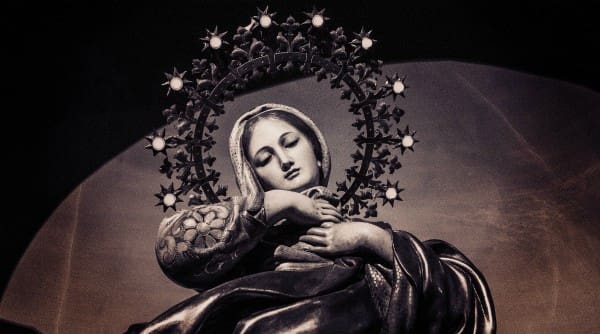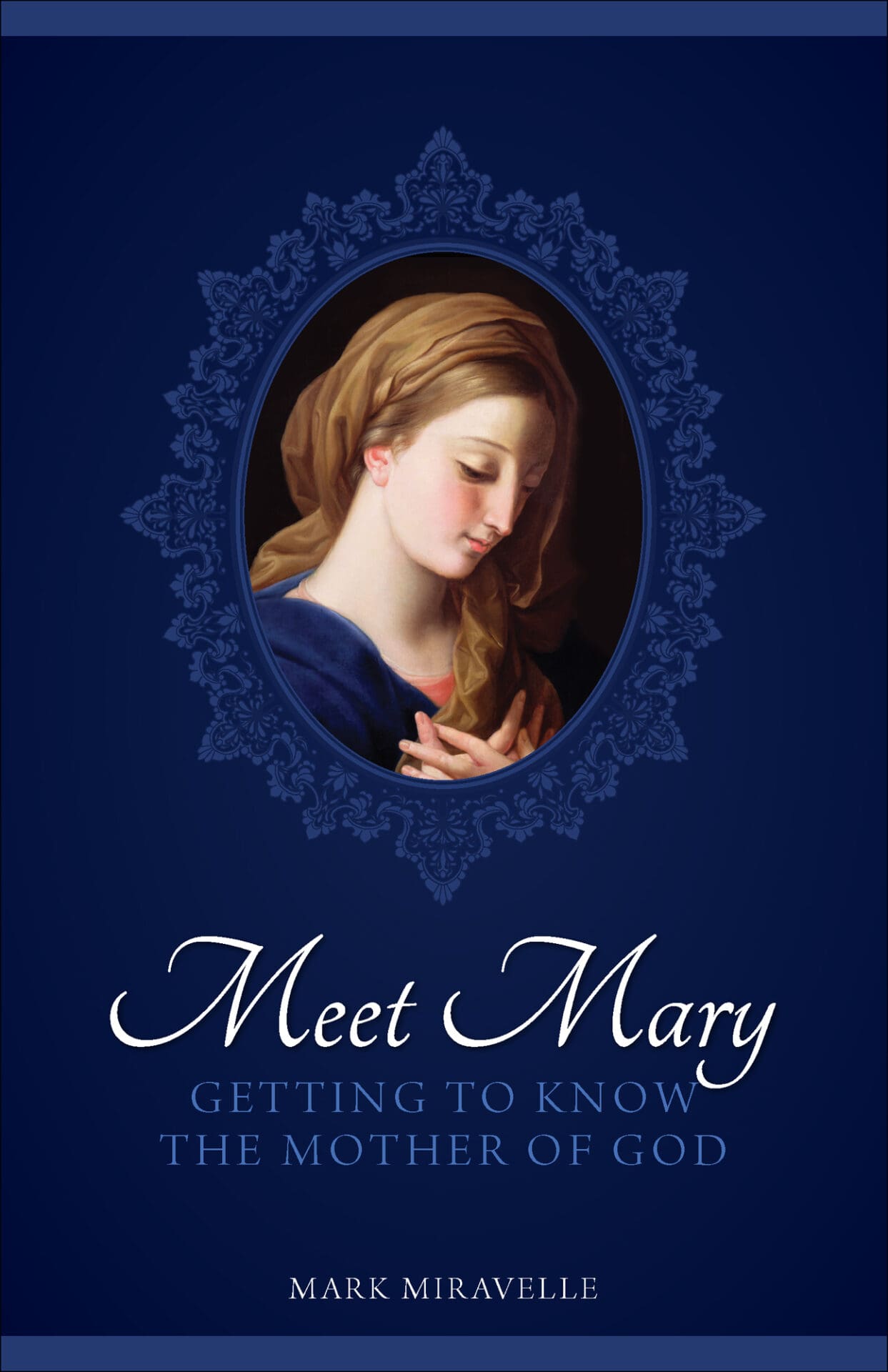The authors of the New Testament focus the overwhelming majority of their attention on Jesus and his ministry, not on his mother. The reasons for this are obvious: Jesus is God, Mary is not. If Christ’s divine nature and primacy were not clearly and solidly established, devotion to his mother would make no sense; worse, it could morph into the type of goddess worship so common in the ancient Near East.
The same principle held true for the early Church. Establishing Christ’s primacy had to come first; otherwise their claims to be the very Body of Christ, would sound like lunacy. Yet even so, we still find acknowledgment of and devotion to the mother of Jesus from apostolic times.
The oldest historical evidence we have of Marian devotion among early Christians comes from the catacombs. These tombs of the Christian dead, scattered throughout the Mediterranean world, bear witness to their affection for Mary, their hope in her intercession, and their confidence in her place in heaven. As early as the end of the first century after Christ, they began including Mary in frescoes on the walls of the Roman catacombs. At times she is shown with her son; at other times she appears alone. Common images include Mary as the model of virginity and Mary as the orans — the woman at prayer. Scenes of Mary at the Annunciation and the Nativity are also on the walls.
One of the most significant frescoes is in the catacombs of St. Agnes in Rome. There, Mary stands between Peter and Paul, her arms outstretched to both. Dating back to the first years of Christianity, whenever Peter and Paul appear together in religious imagery, they are symbolizing the one Church of Christ, a Church of authority and of evangelization, a Church for both Jew and Gentile. Mary’s prominent position between the two illustrates the Apostolic Church’s understanding of her as “Mother of the Church.”
The many images of Mary, and their location within the catacombs, also make it clear that the early Christians saw Mary not simply as a historical person, but as a source of protection and intercession. This symbolic use of her image points to the reality of their relationship with her. In seeing her as the Mother of the Church, they saw her relating to them, to all Christians, as any good mother would: protecting them, teaching them, and helping them by her prayers.
Then, within about a hundred years of Jesus’ death, the leaders and teachers in the early Church had come to describe Mary as “the New Eve.” What did they mean by this?
In Genesis, when Adam sinned, he did not sin alone. His wife disobeyed God before he did and then tempted him to disobedience as well. Man fell from grace, and Original Sin entered his nature because of Adam’s sin, but Eve had played an instrumental role in that Fall.
So, too, with man’s redemption. When man was given the possibility of being restored to grace and cleansed of Original Sin, that possibility came about through Christ’s saving death on the Cross. But at the foot of that Cross was a woman, a woman who had made Jesus’ death possible by making his life possible. With her yes to the angel Gabriel, Mary, like Eve, played an instrumental, albeit secondary role, in man’s redemption.
St. Justin Martyr (d. 165), the early Church’s first great defender of Christian teaching, made much use of this metaphor, describing Mary as the “obedient virgin” in contrast to Eve, “the disobedient virgin”:
[The son of God] became man through the Virgin [so] that
the disobedience caused by the serpent might be destroyed
in the same way in which it had originated. For Eve, while a
virgin incorrupt, conceived the word that proceeded from
the serpent, and brought forth disobedience and death. But
the Virgin Mary was filled with faith and joy when the angel
Gabriel told her the glad tidings . . . And through her he
was born . . .
St. Irenaeus of Lyons (d. 202), another great defender of Christian orthodoxy, also wrote about Mary as the New Eve who participated in Christ’s work of salvation:
Just as Eve, wife of Adam, yet still a virgin, became, by her
disobedience, the cause of death for herself and the whole
human race, so, too, Mary, espoused but yet a virgin, became,
by her obedience, the cause of salvation for herself
and the whole human race . . . And so it was that the knot
of Eve’s disobedience was loosed by Mary’s obedience. For
what the virgin Eve bound fast by her refusal to believe, this
the Virgin Mary unbound by her belief.
Later, St. Ambrose (d. 397) further developed the Christian understanding of the New Eve:
It was through a man and a woman that flesh was cast from
Paradise; it was through a virgin that flesh was linked to
God . . . Eve is called mother of the human race, but Mary
was mother of salvation.
St. Jerome (d. 420) neatly summarized the parallel when he wrote, “Death through Eve, life through Mary.”
In addition to this understanding of Mary’s role in salvation history, the first centuries of Christianity also provide us with numerous examples of direct prayer to Mary as a means of intercession for the graces and protection of her son.
St. Irenaeus referred to Mary as Eve’s special “advocate,” interceding through prayer for her foremother’s forgiveness and salvation, while St. Gregory Thaumaturgus (d. 350) wrote of Mary in heaven praying for those still on Earth.
St. Ephraem (d. 373), one of the great Eastern preachers, prayed to Mary directly in several of his sermons, as did St. Gregory Nanzianzen (d. 389).
From the latter half of the fourth century on, such examples of Marian prayers simply abound, from the sermons of St. Ambrose to those of the Eastern Father St. Epiphanius. The most complete ancient prayer to Mary, however, dates back to an even earlier time, 250 AD. It is called the Sub Tuum:
We fly to your patronage,
O holy Mother of God.
Despise not our petitions
in our necessities,
but deliver us from all dangers,
O ever glorious and blessed Virgin.
The early Christians knew that the same woman who had rocked the infant Jesus to sleep, picked him up when he fell, and held his broken body in her arms could also be trusted to help them through their own trials, both spiritual and temporal. Their trust in and love for Mary was more than evident by 431 AD, when the Council of Ephesus — an authoritative meeting of Church leaders — formally defended her title as “Mother of God.” Already, there were cathedrals dedicated to her in Rome, Jerusalem, and Constantinople, and after the council, devotion to Mary flourished even more in both the East and the West. Marian prayers, Marian liturgical feasts, Marian icons, and Marian paintings were soon everywhere in the Christian world.
The son’s place had been secured, his Church established and fortified. And now, the seeds of truth about his mother, seeds foreshadowed in the Old Testament, planted in the New Testament, and cultivated in the early Church, could finally come to fruition. Nothing that came forth would or could in any way diminish the truth and glory of Christ. Rather, the fruits of authentic Marian devotion could only show more clearly, more beautifully, the possibilities offered to man by Christ’s saving grace.
+
This article is adapted from a chapter in Meet Mary by Mark Miravelle which is available from Sophia Institute Press.
Art for this post on Mary: Cover and featured image used with permission.






